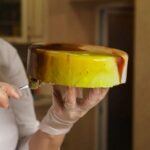Have you ever wondered how to melt chocolate for cake decorating? Melted chocolate is an essential component of many cake decorations, from drizzles and drips to intricate designs and molds. In this article, we will explore the importance of properly melted chocolate for cake decorating, the best types of chocolate to use, essential tools needed, different methods for melting chocolate, troubleshooting tips, and various techniques and ideas for using melted chocolate in cake decorating.
Properly melted chocolate is crucial for achieving smooth, glossy texture and ensuring that it sets correctly for beautiful cake decorations. Whether you’re a professional baker or a novice home cook, mastering the art of melting chocolate can elevate your cake decorating skills and impress your friends and family with stunning confections.
We will discuss the different types of chocolate that are best suited for melting, along with the essential equipment needed to achieve the perfect consistency. Additionally, we will provide detailed instructions on two popular methods for melting chocolate: using a double boiler or a microwave.
Finally, we will offer valuable tips on common mistakes to avoid when melting chocolate and troubleshooting solutions if your chocolate doesn’t melt properly. So let’s dive in and discover everything you need to know about melting chocolate for cake decorating.
Choosing the Right Chocolate for Melting
When it comes to cake decorating, using the right type of chocolate is essential for achieving the best results. Not all chocolates are created equal, and some are better suited for melting and decorating than others. Here are the best types of chocolate to consider for your cake decorating needs:
1. Bittersweet Chocolate: This type of chocolate has a higher cocoa content and less sugar, making it ideal for melting and creating rich, dark chocolate decorations.
2. Semisweet Chocolate: Similar to bittersweet chocolate, semisweet chocolate is another great option for cake decorating. It has a slightly lower cocoa content and a sweeter flavor, making it perfect for those who prefer a less intense chocolate taste.
3. White Chocolate: While technically not true chocolate since it doesn’t contain cocoa solids, white chocolate is a popular choice for decorative purposes due to its creamy texture and ability to be colored with food-safe dyes.
4. Dark Chocolate: Dark chocolate with at least 70% cocoa content is also suitable for melting and decorating cakes. It provides a robust flavor and deep color that can enhance the overall look of your cake.
When selecting the right type of chocolate for melting, it’s important to consider the intended use and flavor profile of your cake. Experimenting with different types of chocolates can help you find the perfect one for your specific decorating needs. Ultimately, choosing high-quality chocolate will ensure a smooth and luscious consistency when melted, resulting in beautiful decorations for your cakes.
Equipment Needed
When it comes to cake decorating, properly melted chocolate is essential for achieving the desired look and taste. In order to successfully melt chocolate for cake decorating, it’s important to have the right tools on hand. The equipment needed for melting chocolate may vary depending on the method you choose, but there are some essential tools that are universally recommended.
One of the most important tools for melting chocolate is a heatproof bowl. This can be either glass or metal, but it must be able to withstand heat without cracking or warping. A good quality heatproof bowl will help to ensure that the chocolate melts evenly and without burning. Additionally, a spatula or spoon for stirring is necessary to ensure that the chocolate melts consistently throughout the process.
Another essential tool for melting chocolate is a double boiler or a heatproof pot and a metal or heatproof glass bowl. This setup allows you to create a gentle and indirect heat source for melting the chocolate, reducing the risk of scorching or burning. If you choose to melt your chocolate in the microwave, a microwave-safe bowl will be necessary instead.
Finally, having a reliable kitchen thermometer can also be beneficial when melting chocolate for cake decorating. This will allow you to monitor the temperature of the chocolate as it melts, ensuring that it reaches and maintains the proper consistency for decorating your cake.
Method 1
When it comes to cake decorating, properly melted chocolate is essential for achieving the perfect look and flavor. One of the most reliable methods for melting chocolate is by using a double boiler. This gentle heating process ensures that the chocolate melts evenly without scorching or burning.
Setting Up Your Double Boiler
To begin, you will need a saucepan and a heatproof bowl that fits snugly on top of the saucepan without touching the water. Fill the saucepan with an inch or two of water and bring it to a simmer over medium heat. Once the water is simmering, reduce the heat to low to maintain a gentle, steady heat.
Melting the Chocolate
Break your chosen type of chocolate into small, uniform pieces for even melting. Place the chocolate pieces in the heatproof bowl and set it on top of the saucepan with simmering water. Using a rubber spatula, gently stir the chocolate as it melts, ensuring that no steam or water from the double boiler gets into the bowl.
Troubleshooting Tips
If your chocolate begins to seize or becomes lumpy while melting in the double boiler, remove it from the heat immediately and stir in a small amount of vegetable oil or shortening to smooth it out. Be sure not to overheat your chocolate as this can cause it to become grainy or scorched.
Keeping a close eye on your chocolate and stirring it regularly will help you avoid these common issues when using a double boiler to melt chocolate for cake decorating.
By mastering this method, you’ll be well on your way to creating beautifully decorated cakes with perfectly melted chocolate.
Method 2
When it comes to melting chocolate for cake decorating, using a microwave can be a quick and efficient method. Here’s how to melt chocolate using a microwave:
1. Prepare the Chocolate: Break the chocolate into small, evenly-sized pieces. This will ensure that the chocolate melts evenly and prevents any burning.
2. Microwave Safe Bowl: Place the chocolate pieces in a microwave-safe bowl. A glass or ceramic bowl is ideal for melting chocolate in the microwave.
3. Microwave in Intervals: Heat the chocolate in the microwave at 50% power for 30 seconds intervals, stirring well after each interval. It’s important to heat at a lower power setting to avoid scorching the chocolate.
4. Stirring: Stirring is crucial when melting chocolate in the microwave to ensure even melting and to prevent overheating. The residual heat from stirring will continue to melt any remaining chunks of chocolate.
5. Additional Tips: Adding a small amount of coconut oil to the chopped chocolate can help make it more fluid and easier to work with when decorating your cake.
This method allows you to quickly and easily melt chocolate for cake decorating, but it’s important to keep an eye on the process as microwaves can vary in power. With these steps, you’ll have beautifully melted chocolate ready for creating stunning decorations on your cakes.
Tips for Successfully Melting Chocolate
Melting chocolate for cake decorating can be a delicate process, but with the right tips and techniques, it can be easily mastered. One of the most common mistakes to avoid when melting chocolate is introducing even the smallest amount of water into the mix. Any contact with water can cause the chocolate to seize, making it lumpy and unusable for decorating purposes.
Another crucial tip for successfully melting chocolate is to use low heat and to melt it slowly. This will help prevent the chocolate from scorching or burning, which can give it a bitter taste. Additionally, stirring the chocolate frequently while melting will ensure that it melts evenly and smoothly.
It’s also important to avoid overheating the chocolate. Overheating can cause the cocoa butter in the chocolate to separate, creating a grainy texture that is not ideal for cake decorating. By following these tips, you can ensure that your melted chocolate remains smooth and glossy, perfect for creating beautiful decorations on your cakes.
| Common Mistakes | Action |
|---|---|
| Introducing water | Avoid any contact with water to prevent seizing |
| Using high heat | Melt chocolate slowly over low heat to prevent scorching |
| Overheating | Avoid overheating which causes the cocoa butter to separate |
Using Melted Chocolate for Cake Decorating
When it comes to cake decorating, using melted chocolate opens up a world of possibilities for creative designs and delicious flavors. From drizzling and piping to molding and creating intricate decorations, knowing how to properly melt and use chocolate can take your cake decorating skills to the next level.
Drizzling and Piping
One of the simplest ways to use melted chocolate for cake decorating is by drizzling or piping it onto the surface of the cake. Whether you’re creating a simple yet elegant design or adding a burst of flavor with a chocolatey swirl, mastering the technique of drizzling and piping can add a professional touch to your cakes.
Molding Chocolate Decorations
Melted chocolate can also be used to create stunning molded decorations for cakes. By using molds in various shapes and designs, you can make intricate chocolate decorations that will impress your guests. From delicate flowers to cute animals, the possibilities are endless when it comes to molding chocolate for cake decorating.
Creating Chocolate Garnishes
In addition to using melted chocolate for drizzling, piping, and molding, you can also use it to create beautiful chocolate garnishes for your cakes. By spreading melted chocolate onto a flat surface, letting it set slightly, and then cutting or shaping it into unique designs, you can add an extra element of beauty and flair to your cake creations.
Incorporating these different techniques for using melted chocolate in your cake decorating endeavors can elevate your creations from ordinary to extraordinary. Whether you’re a beginner or an experienced baker, experimenting with these ideas will allow you to enhance the visual appeal and taste of your cakes.
Troubleshooting
If your chocolate doesn’t melt properly when you’re trying to decorate a cake, don’t panic. There are a few common reasons why this might happen, and with a bit of troubleshooting, you can salvage your chocolate and still create beautiful decorations for your cakes.
One of the most common reasons for chocolate not melting properly is introducing moisture into the process. Even a tiny amount of water can cause the melted chocolate to become thick and grainy. To avoid this, make sure that all of your equipment is completely dry before you start melting the chocolate. Additionally, be cautious when using steam or condensation from the sides of the bowl when using a double boiler method.
Another reason for improperly melted chocolate is overheating. Chocolate should be melted at a low and gentle heat to prevent it from burning or becoming lumpy. If you’re using a microwave, use short intervals and stir frequently to ensure that the chocolate melts evenly without getting too hot.
If you find that your chocolate is too thick or has seized up while melting, you can try adding small amounts of vegetable oil or cocoa butter to help smooth it out. This will help restore the proper consistency for decorating your cake. And if all else fails, you can always start over with new chocolate – practice makes perfect.
Conclusion
In conclusion, mastering the art of melting chocolate is essential for creating beautiful and professional-looking cake decorations. Whether you are a seasoned baker or just starting out, knowing how to properly melt chocolate can take your cake decorating skills to the next level. By following the tips and techniques outlined in this article, you can ensure that your melted chocolate is smooth, glossy, and perfect for creating stunning designs on your cakes.
One of the most important factors in successfully melting chocolate for cake decorating is choosing the right type of chocolate. Using high-quality chocolate with a good cocoa content will result in a smoother and more flavorful melted chocolate.
Additionally, using the right equipment, such as a double boiler or microwave, can make the melting process much easier and more efficient. By following these guidelines, you can avoid common mistakes and troubleshoot any issues that may arise during the melting process.
Whether you are using melted chocolate to drizzle over a cake, create intricate designs, or make decorative shapes, having a good understanding of how to melt chocolate for cake decorating is crucial. With practice and patience, you can develop your own techniques for using melted chocolate to enhance the appearance and flavor of your cakes. So go ahead and experiment with different methods and ideas to make your cakes stand out with beautifully crafted chocolate decorations.
Frequently Asked Questions
How Do You Melt Chocolate for a Cake?
To melt chocolate for a cake, you can use a double boiler or microwave. If using a double boiler, simply place the chocolate in the top bowl and stir until melted. If using a microwave, heat the chocolate in short intervals, stirring in between.
How Do You Melt Chocolate to Decorate?
When melting chocolate to decorate, it’s important to use low heat and stir frequently to prevent burning. You can use a piping bag or spoon to drizzle the melted chocolate over your desserts to create beautiful designs and patterns.
Can I Decorate a Cake With Melted Chocolate?
Yes, you can definitely decorate a cake with melted chocolate! It’s a delicious and versatile way to add flavor and decorative flair to your cakes. Whether you’re creating intricate designs or simply drizzling chocolate over the top, it’s sure to impress your guests.

Welcome to my blog about home and family. This blog is a place where I will share my thoughts, ideas, and experiences related to these important topics. I am a stay-at-home mom with two young children. I hope you enjoy reading it! and may find some helpful tips and ideas that will make your home and family life even better!





